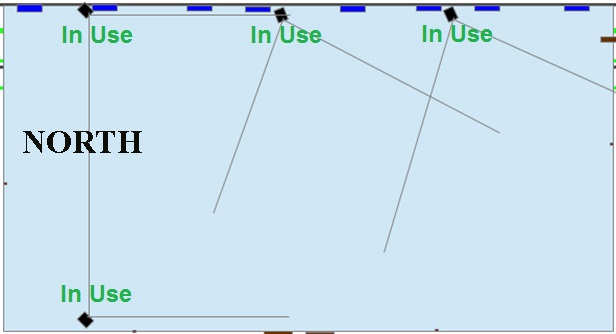Fellowship Hall Sound Set-up
12/30/2017 update
A/V Operators
Overview
The fellowship hall sound system consists of a lockable portable rack with a powered mixer/amp, speaker cables and connections, a wired microphone, a wireless receiver, and assorted cables/remotes:
There are four speakers mounted to the walls, two at the north end (east and west walls), and two others on the east wall.
These speakers are connected via low-voltage wiring to the wall jacks on the west wall, north end.
This picture shows the two north end speakers connected:
On the top of the rack is a jack panel with connections for speakers, and the antennas for the wireless microphone system.
This picture shows one of each speaker hooked up to each amplifier - left and right:
The amplifiers can handle speaker loads down to 4 ohms. Since each of our speakers is 8 ohms, we can plug up to two speakers into each amplifier section.
There are three common set-up configurations:
1) North facing, small group
This is best for projection for a smaller group.
The second and third speakers on the east wall are not used.
2) North facing, large group
The size of the screen makes large group viewing of videos or presentations less satisfactory near the south end of the room.
The second and third speakers on the east wall may be used to boost the sound in the back of the room. These will need to be plugged into the jack panel as well.
This is also the configuration to use if the sound system is just being used for background music.
The wired microphone may be used with attention to the safe location of the cable (avoid trip hazards). It is preferred to use the wireless mic if only one person is to speak at a time.
3) East facing
This configuration may be used for large meetings such as combined Sunday School, or a Bible study.
With the addition of the new partition in the fellowship hall, projection is not advised. The viewing angle for the projection screen becomes problematic at the left and right edges of the audience, depending on the size.
It is important for anyone speaking with a microphone to stay near the east wall, and centered between the speakers to avoid feedback. The center between the speakers is not the center of the room.
Sometimes the person speaking will relocate to the center of the room regardless of where you initially set up. In that case, you may have to use an alternate speaker set-up to avoid feedback.
This involves unplugging the middle speaker on the east wall, and plugging in the north speaker on the east wall.
There is a wired microphone in the cabinet for simple set-ups. For a single person speaking, use of a wireless mic is preferred. The Line 6 wireless receiver is set for channel 3, which is the channel that the pastor's wireless headset uses. The best sound and freedom from feedback is provided by the headset mic. If the person speaking does not want to use the headset mic, it can be replaced with a lapel mic, using the same transmitter and channel.
If multiple people will be speaking in succession, the channel 3 wireless hand-held mic is a better choice. It can be placed on a stand and turned on for each person to use, without having to swap headset or lapel mics. This option will be the least attractive from a feedback standpoint, since the distance between the person and the mic is not necessarily optimum or consistent, and if they do not speak loudly, turning up the volume to hear them risks feedback.
Note that you cannot use both channel 3 wireless mic transmitters at the same time.
If multiple microphones are required, such as for a band or singing group, it will be necessary to run mic cables from the area of the sound rack to the stage area, being mindful of causing trip hazards. The best approach is to run the cables along the base of the wall to the stage area. Tape down any cables running in traffic areas (wide masking tape).







